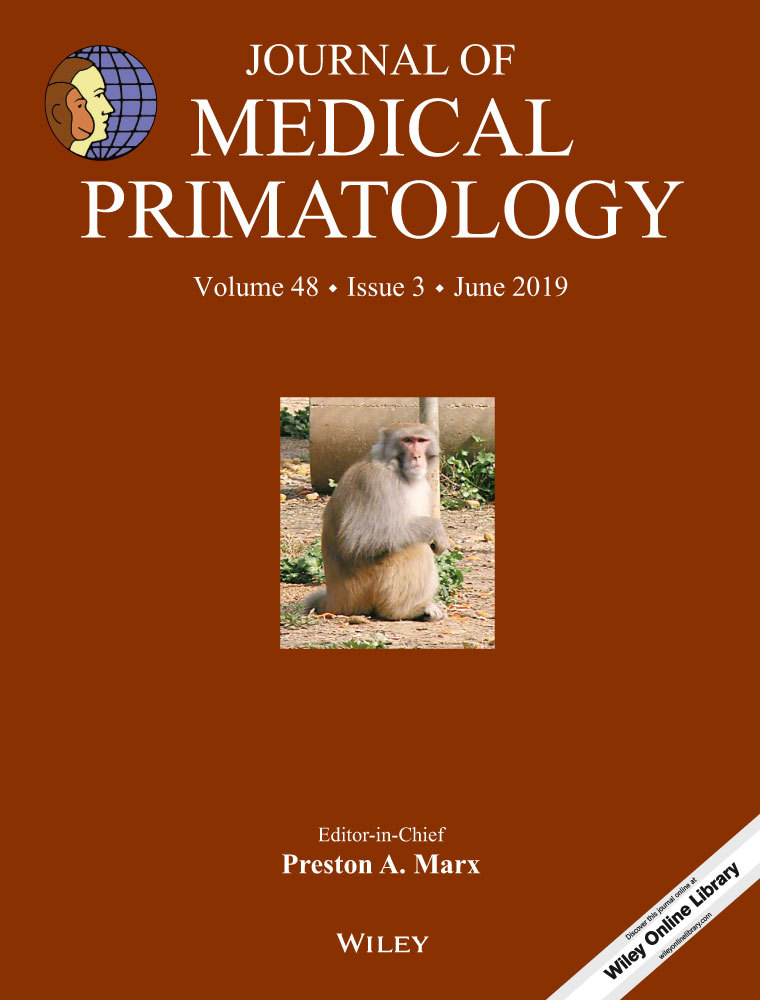Candida albicans-associated sepsis in a pre-term neonatal rhesus macaque (Macaca mulatta)
Corresponding Author
Heidi L. Pecoraro
Oregon National Primate Research Center, Division of Comparative Medicine, Oregon Health & Science University, Portland, Oregon
Correspondence
Heidi Pecoraro, Veterinary Diagnostic Services Department, North Dakota State University, Fargo, North Dakota.
Email: [email protected]
Search for more papers by this authorMelissa R. Berg
Oregon National Primate Research Center, Division of Comparative Medicine, Oregon Health & Science University, Portland, Oregon
Search for more papers by this authorBrandy L. Dozier
Oregon National Primate Research Center, Division of Comparative Medicine, Oregon Health & Science University, Portland, Oregon
Search for more papers by this authorLauren Drew Martin
Oregon National Primate Research Center, Division of Comparative Medicine, Oregon Health & Science University, Portland, Oregon
Search for more papers by this authorCindy T. McEvoy
Department of Pediatrics, Division of Neonatology, Oregon Health & Science University, Portland, Oregon
Search for more papers by this authorMichael H. Davies
Division of Neuroscience, Oregon Health & Science University, Portland, Oregon
Search for more papers by this authorRebecca Ducore
Oregon National Primate Research Center, Division of Comparative Medicine, Oregon Health & Science University, Portland, Oregon
Search for more papers by this authorCorresponding Author
Heidi L. Pecoraro
Oregon National Primate Research Center, Division of Comparative Medicine, Oregon Health & Science University, Portland, Oregon
Correspondence
Heidi Pecoraro, Veterinary Diagnostic Services Department, North Dakota State University, Fargo, North Dakota.
Email: [email protected]
Search for more papers by this authorMelissa R. Berg
Oregon National Primate Research Center, Division of Comparative Medicine, Oregon Health & Science University, Portland, Oregon
Search for more papers by this authorBrandy L. Dozier
Oregon National Primate Research Center, Division of Comparative Medicine, Oregon Health & Science University, Portland, Oregon
Search for more papers by this authorLauren Drew Martin
Oregon National Primate Research Center, Division of Comparative Medicine, Oregon Health & Science University, Portland, Oregon
Search for more papers by this authorCindy T. McEvoy
Department of Pediatrics, Division of Neonatology, Oregon Health & Science University, Portland, Oregon
Search for more papers by this authorMichael H. Davies
Division of Neuroscience, Oregon Health & Science University, Portland, Oregon
Search for more papers by this authorRebecca Ducore
Oregon National Primate Research Center, Division of Comparative Medicine, Oregon Health & Science University, Portland, Oregon
Search for more papers by this authorAbstract
Invasive Candida infections (ICI) have been associated with neurodevelopmental impairment or death in human pre-term neonates. Candidiasis in nonhuman primates is seen mostly in immunosuppressed animals, and ICI is not commonly reported. Here, we report a case of Candida albicans-associated ICI in a pre-term neonatal rhesus macaque.
CONFLICTS OF INTEREST
The authors declare no potential conflicts of interest with respect to the research, authorship, or publication of this article.
REFERENCES
- 1Sonnenschein-van der Voort AMM, Arends LR, de Jongste JC, et al. Preterm birth, infant weight gain, and childhood asthma risk: a meta-analysis of 147,000 European children. J Allergy Clin Immunol. 2014; 133(5): 1317-1329.
- 2Wyckoff MH, Aziz K, Escobedo MB, et al. Part 13: neonatal Resuscitation: 2015 American Heart Association Guidelines Update for Cardiopulmonary Resuscitation and Emergency Cardiovascular Care. Circulation. 2015; 132: S543-S560.
- 3Friedman S, Richardson SE, Jacobs SE, O'Brien K. Systemic Candida infection in extremely low birth weight infants: short term morbidity and long term neurodevelopmental outcome. Pediatr Infect Dis J. 2000; 19(6): 499-504.
- 4Stoll BJ, Hansen NI, Adams-Chapman I, et al. Neurodevelopmental and growth impairment among extremely low-birth-weight infants with neonatal infection. JAMA. 2004; 292(19): 2357-2365.
- 5Benjamin DK Jr, Stroll BJ, Fanaroff AA, et al. Neonatal candidiasis among extremely low birth weight infants: risk factors, mortality rates, and neurodevelopmental outcomes at 18 to 22 months. Pediatrics. 2006; 117(1): 84-92.
- 6Benjamin DK Jr, Stoll BJ, Gantz MG, et al. Neonatal candidiasis: epidemiology, risk factors, and clinical judgment. Pediatrics. 2010; 126(4): e865-e873.
- 7Lee JH, Hornik CP, Benjamin DK, et al. Risk factors for invasive candidiasis in infants >1500 g birth weight. Pediatr Infect Dis J. 2013; 32(3): 222-226.
- 8Swanson JR, Gurka MJ, Kaufman DA. Risk factors for invasive fungal infection in premature infants: enhancing a targeted prevention approach. J Pediatric Infect Dis Soc 2014; 3(1): 49-56.
- 9Simmons J, Gibson S. Chapter 2: bacterial and mycotic diseases of nonhuman primates. In: C Abee, K Mansfield, S Tardif, T Morris, eds. Nonhuman Primates in Biomedical Research, 2nd edn. London NW: Academic Press; 2012.
10.1016/B978-0-12-381366-4.00002-X Google Scholar
- 10Migaki G, Schmidt RE, Toft JD II, Kaufmann AF. Mycotic infections of the alimentary tract of nonhuman primates: a review. Vet Pathol. 1982; 7(Suppl): 93-103.
- 11Osborn KG, Prahalada S, Lowenstine LJ, Gardner MB, Maul DH, Henrickson RV. The pathology of an epizootic of acquired immunodeficiency in rhesus macaques. Am J Pathol. 1984; 114: 94-103.
- 12McCullough B, Moore J, Kuntz RE. Multifocal candidiasis in a capuchin monkey (Cebus apella). J Med Primatol. 1977; 6: 186-191.
- 13Wikse SE, Fox JG, Kovatch RM. Candidiasis in simian primates. Lab Anim Care. 1970; 20: 957-963.




